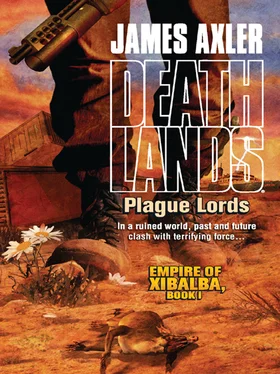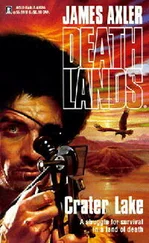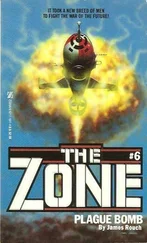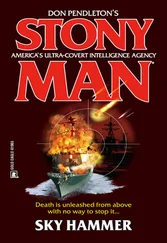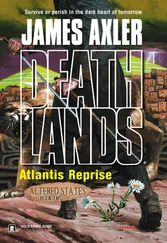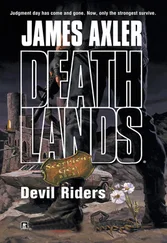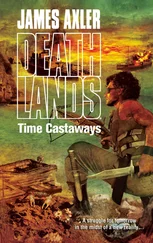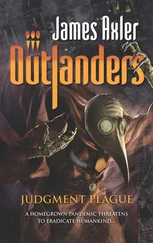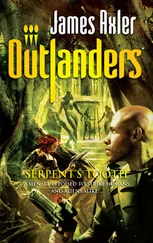A self-guided sightseeing tour of the island’s shantytown had told Daniel what was stored in the container ship: white running shoes aplenty, wardrobes of summer fashion, circa 1999, and plastic lawn furniture. But also toothbrushes and toothpaste, toilet paper, linens, bathware and canned goods in profusion. Empty tins of pork and beans, peas, pearl onions, peaches, black olives and potted meat lay scorched in the camp middens, as well as cast-off plastic packaging from barbecue potato chips, honey-roasted peanuts, jerky sticks, cookies and candy bars. Daniel had seen bag charcoal, car batteries, spark plugs, fan belts, flatware, dishes, pots and pans, stuffed toys, cooking oil, and grooming and beauty products—bar soaps, lotions and lipsticks. There was also a variety of made-in-India, factory-loaded ammo: 9 mm Parabellum, 7.62 mm Russian and 12-gauge low-brass quail loads, among others. Apparently, the Yoko Maru held a large stockpile of predark centerfire munitions.
As he prattled away on automatic to his spellbound audience, Daniel took in the islanders’ highly organized defensive preparations, the lines of people moving on and off the ship, the self-sacking of the ville. They had a good plan. Obvious, but good. From the hard looks he was getting, they suspected him of something far more nefarious than rotting the minds of droolies—as if their suspicions mattered at this point. The fight for the island was already lost; the Nuevo-Texicans just didn’t know it…yet.
“Battle armor! Battle armor!” Daniel’s audience hollered, shattering his reverie. “Battle armor! Battle armor!”
He held up his hands for quiet. “All right, all right,” he conceded, “but this is absolutely the last time today…”
To the delight of his listeners, in highly numeric and acronymic detail Daniel went over the specifications of the Martian-made assault gear, down to the chemical composition of the metallic-plastic alloys, the thicknesses of individual body plates and the “theory” behind the nanotech circuitry they contained.
After the companions had motored three miles up the road, Ryan signaled for a pull over and parlay. As the dust settled around them, Krysty, J.B., and Jak killed the motorcycles’ engines and everyone dismounted. No longer in motion, they felt the full impact of the sweltering heat.
The first words out of Ryan’s mouth were, “Check your ammo.”
The one-eyed man didn’t have to check his own. Every round he had left was loaded up, seven shots in the Steyr’s box mag, a full 15-round clip in the SIG-Sauer. While the one-eyed warrior unslung his longblaster and stood lookout, Krysty, Mildred, J.B., and Jak started their round counts. Doc, the deep creases of his prematurely aged face rimed with dirt and sweat, retired to a wide sandstone boulder at the side of the road.
Ryan watched the time traveler take a seat on the low rock and carefully lay down his sword stick. Doc dug black-powder reloading gear from his frock coat’s pockets.
More than once over the years Ryan and J.B. had tried to talk him into switching over to a weapon-chambered centerfire, but he wouldn’t hear of it. Doc was one hard-headed Victorian son of a bitch. No matter what they said, he always argued that the proof was in the chilling. And that he had never had a problem doing that with the 250-year-old LeMat. Privately, J.B. assured Ryan that someday the radblasted thing was going to explode in his hand like a frag gren.
Doc prided himself on how fast he could reload his treasured if obsolete weapon. And Ryan had to admit he was plenty fast. Since the immediate danger was miles behind them, Doc gave the chambers and both barrels a quick going over with the bore brush to scour away the worst of the burned residue. He lined up the first chamber with the hammer at halfcock and the muzzle aimed skyward, then unsnapped the pistol’s jointed rammer from its barrel clip. He measured the powder, poured it into the shallow chamber, and levered the rammer to seat a lead ball on top of it. After flicking away the little ring of excess lead the lip’s tight fit trimmed off, he put dab of grease over the bullet to lube the barrel and keep the sparks from other chambers from causing spontaneous ignition when they fired. Rotating the cylinder a full notch, he proceeded to load the next chamber, and the next, and the next, and so on. His rate of speed was as steady as his hands. After he finished the ninth chamber he securely snapped the rammer back into its clip.
The .63-caliber shotgun chamber he loaded last, using a homemade wooden ramrod to seat the aft wadding, grapeshot and front wadding. He capped all ten chambers, lowered the hammer into one of the safety notches between nipples and slipped the massive blaster back into its hand-tooled Mexican holster.
Just under five minutes had elapsed from start to finish.
In the meantime, the other companions had taken stock of what was left of their ammo. J.B. had six high-brass rounds in his M-4000’s tubular magazine. Mildred and Krysty had full cylinders in their revolvers. They had used up their speedloaders; between them they had eight loose shells. Jak had two .357 Magnum bullets left in his revolver and nothing in his pockets. Of the six, only Mildred and Krysty could swap cartridges back and forth interchangeably as they both carried .38 Specials. They evened things out with Jak, giving him a couple of bullets each. Jak could fire their .38s in his .357, but they couldn’t shoot his cartridges because of the Magnum’s longer case.
J.B. was the first to dig into one of the looted backpacks.
“Well, lookee here!” he exclaimed, holding up a plastic-wrapped, gold-colored brick for all to see.
Taped to the outside of the kilo of C-4 was a sealed blister pack that contained blasting caps and electronic trigger, radio detonator and two sets of lithium batteries—one to set off the cap, one for the remote detonating device. As a backup, there was also a coil of thick, white blasting cord.
Ryan and the other companions quickly dumped out the contents of the other five packs. There was no ammo. No food. No water. Just predark plastic explosive and detonators. There was enough plastique piled in the middle of the road to turn a square city block into rubble.
“Well, we know the stuff still works,” Mildred said.
“Stickies found that out the hard way,” Krysty said. J.B. turned the brick over in his hand and read the text on the packaging. “Check the address,” he said, showing Ryan what was written.
“What is the significance of the label?” Doc asked, staring down at a brick he had picked up.
“Back in the day,” Ryan explained, “when J.B. and me were running with Trader, there was a rumor going around about a predark industrial plant in western New Mex, where the government used to turn high ex into C-4. Supposedly the finished product was stored in deep, blastproof bunkers in the desert. Looks like our dead scroungers stumbled on the motherload.”
“Worth big jack,” Jak said appreciatively, toeing the pile with a boot tip.
“To the right buyer,” Mildred said. “The trouble is, we’re a long way from the nearest baron.”
Ryan nodded. Mildred was on target, as usual. HE was a useful tool in the defense of territory, and in taking territory away from someone else; it was a weapon of war. For the hellscape’s smaller scale, everyday business of robbing, extortion, forced servitude and the like, it was serious overkill.
“It’s still worth plenty to a middleman,” Ryan countered. “We’ve got to find someone who has what we need, short-term. Ammo, food, water and gas for the bikes. If we can trade away a small part of the stash, we can haul the rest of it east, where it will bring the most jack. Check the fuel in the bikes.”
Читать дальше
